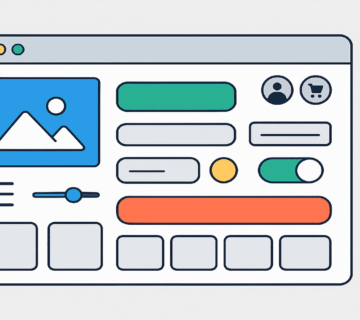Best Website Design Practices to Increase Conversion Rate
Introduction to Website Design & Conversion Rate
Website design is one of the decisive factors in achieving online success. It plays a major role in attracting visitors and motivating them to explore the content and products offered. A visually appealing, consistent design not only draws attention, but also affects the overall user experience. This means that businesses must pay special attention to their website design to provide a smooth and comfortable experience for users.
Conversion rate, defined as the percentage of visitors who take a certain action (such as making a purchase or subscribing to a newsletter), is a crucial metric tied either to commercial success or failure.
Simply put, the higher the conversion rate, the greater the probability of earning revenue and achieving sustainable success. Hence, improving the conversion rate becomes essential for businesses of all sizes.
Improving conversion rate can be achieved by adopting effective design practices. These include enhancing the user interface, ensuring fast page load times, and using responsive designs to meet the needs of different devices.
In addition, it is important to focus on delivering persuasive content and employing effective marketing techniques like A/B testing and visitor data analytics. All of these elements help improve the user experience, which ultimately leads to a higher conversion rate, attracting new customers and improving the overall business performance.
Understanding Your Target Audience
Understanding your target audience is a foundational step in designing websites with the aim of increasing conversion rate. This requires conducting market research to identify target segments and analyze their needs and desires. This process begins by collecting accurate data about the current market, enabling you to develop a strategy that aligns with their expectations.
After completing market research, the next step is creating user personas. These personas represent detailed profiles of potential customers—including their ages, interests, and online behaviors. These personas help designers and developers grasp the tendencies of the target audience, enabling them to create a user experience that better fits.
Furthermore, you should analyze trends and behaviors related to your audience. You can use analytics tools to understand how visitors interact with your site and which content attracts their attention. This includes studying the most visited pages, time spent by visitors, and bounce rates. This information allows you to adjust design and content to more closely match the expectations and needs of your audience, thereby increasing the likelihood of converting visitors into potential customers.
With deep understanding of your target audience, you will have the ability to design a user experience that meets their needs and expectations, which contributes significantly to boosting conversion rates. Invest time in this stage, and you will reap positive results in the future.

Designing an Intuitive User Interface
User Interface (UI) design is a critical element for any website aiming to increase conversion rate. The design must be intuitive and easy to use so that users can navigate content smoothly and effectively. To accomplish this, designers should consider several essential elements.
First, information should be arranged in a clear logical order. It is preferable to organize content in a way that allows visitors to quickly understand the information they need. Using a balanced layout of text and images helps greatly in meeting this requirement.
In addition, color choice is a crucial factor in UI design. Colors should be consistent and reflect your brand identity, while also contributing to a comfortable visual experience. For example, bright colors may enhance energy and positivity, while darker tones may convey professionalism.
Moreover, the design and clarity of buttons play a key role in improving the browsing experience. Buttons should be visible and attractive, guiding users toward the desired actions, such as signing up or purchasing. The design should also incorporate natural pauses between elements to create whitespace, which enhances content clarity and allows users to focus without feeling cluttered.
Ultimately, creating an intuitive UI requires integrating these elements coherently, making it easier for users to interact with the site and increasing the likelihood of meaningful engagement.
Improving Website Load Speed
Load speed has become one of the main factors influencing user experience and conversion rate. Studies indicate that visitors tend to leave websites that take too long to load, negatively impacting the chance of converting visitors into customers. Thus, improving site load speed is vital for enhancing performance and raising conversion rate.
To effectively improve site speed, several practices can be implemented. First, review and compress images using efficient formats like WebP, which reduce file size without degrading quality. The smaller the images, the faster they load—this increases user satisfaction and lowers bounce rate.
Additionally, it is important to optimize your website’s code. This can be done by minimizing CSS and JavaScript files, and using techniques like bundling and minification. By reducing the number of server requests, the site can load more quickly, improving the user experience. It is also recommended to use page caching, which stores fragments of the site in visitors’ memory, reducing loading time on repeat visits.
Furthermore, Content Delivery Networks (CDNs) can help speed up your site. CDNs distribute content across multiple servers around the world, improving access speed regardless of geographic location. In this way, visitors receive information more rapidly, which contributes to better conversion rates.
Compelling and Effective Content
High-quality content is one of the essential factors in website design to increase conversion rate. Writers should focus on creating engaging content that is clear and direct to capture visitors’ attention. Writing strategies play a critical role here: content should address the needs and expectations of your target audience. It is important that the content begins with a strong opening sentence containing a hook or new information that encourages the reader to continue.
Furthermore, content must be optimized for Search Engine Optimization (SEO), so visitors can easily find it. Use relevant keywords appropriately without overstuffing, to maintain quality. Headings and subheadings can be used to guide readers through the text and improve ranking in search result pages.
To make content more appealing, you can use visual elements such as infographics and videos. Infographics simplify complex information, making it easier to understand, while videos add an extra layer of engagement and can powerful convey messages effectively.
Putting all these elements together can positively impact your website’s conversion rate. By providing valuable content that respects visitors’ interests and preferences, users will gain trust and feel confident in taking real steps in interacting with your brand, which enhances your chances of achieving your business goals.
Use Clear Calls to Action (CTAs)
Calls to Action (CTA) are vital design elements for websites, significantly contributing to higher conversion rates. These prompts guide visitors toward taking specific actions—whether subscribing, downloading content, or making a purchase. To ensure their effectiveness, CTAs must be clearly designed and compelling.
First, CTAs should be visible and attractive. This can be achieved by using contrasting colors that stand out from the rest of the page. For instance, on a white background, green or red buttons may draw attention. CTA text should be concise and strong, such as “Subscribe Now” or “Get the Offer.”
Second, placement is crucial. CTAs should be placed strategically—at the top of the page, in the midst of content, or at the end of articles. Techniques like scroll triggers can also help present CTAs at the right moment. These methods create a sense of urgency and motivation, making visitors more likely to take action.
Finally, implement A/B testing to determine which messages or designs produce the highest conversion rates. By analyzing data, CTAs can be refined to better suit visitor needs. Using clear and optimized CTAs is a powerful tool to boost engagement and increase conversions on your site.
Responsiveness & Multi‑Device Compatibility
In today’s internet world, it’s essential for a website to be responsive across all devices. Responsive design is crucial for increasing conversion rate, as it provides a smooth user experience on smartphones, tablets, and desktops. Responsive design adjusts content suitably to different screen sizes, enhancing user engagement with the brand and motivating users to take required actions—such as making a purchase.
Techniques to achieve responsiveness include using flexible CSS styles, fluid grid layouts, and images that adapt to screen size. With flexible CSS, developers can adjust interface elements to fit available display space, helping avoid horizontal scrolling which frustrates mobile users.
Furthermore, the design should consider all platforms—testing the site across operating systems like iOS and Android, and across different browsers. This ensures that your target audience enjoys a consistent user experience regardless of the device. Performance improvements—like reducing page load times—also reduce bounce rates and increase chances of conversion.
It is also crucial that the interface be clear and simple so visitors can quickly find needed information. Responsive design not only improves user experience but also plays a key role in meeting business objectives and increasing conversion rate.
Using Analytics to Improve Design
Analytics tools are foundational in refining website design to increase conversion rate. These tools provide precise data on visitor behavior, helping understand how users interact with different site elements. By analyzing available data, website owners can identify strengths and weaknesses in their page designs.
For example, tools like Google Analytics can track visitor behavior such as time spent on site, most visited pages, and exit rates. This information reveals which pages are well optimized and which need adjustment to yield better results. By monitoring these patterns, you can make informed decisions on improving user experience and in turn boosting conversion rate.
Additionally, A/B testing can be used to test design variations and identify which is more effective. By running such experiments, you obtain direct data on how elements like colors, text, and layouts influence user behavior. This method allows designers to refine designs based on real evidence rather than assumptions.
Analytics should not just be recognized as important—they should be considered the core tool that enhances the creativity of designers and developers. Thus, using analytics is a vital component of implementing effective improvements rooted in deep understanding of user needs and trends. Consequently, employing these tools helps achieve business goals and significantly increase conversion rates.
A/B Testing to Improve Conversion Rate
A/B testing is a powerful tool for refining website design and increasing conversion rate. This method compares two versions of a page to see which performs better. Visitors are split into two groups: one interacts with the original version, and the other with a modified version. This approach helps uncover how small design changes can substantially influence visitor behavior, often leading to higher conversion rates.
To run a successful A/B test, follow a structured procedure. First, define the primary objective of the test—such as increasing clicks on a particular button or improving sign‑ups. Next, design two versions of the page containing key differences, such as changing the color of the CTA button or modifying the headline. Focus these changes on elements likely to impact user experience.
After setup, visitors are randomly assigned to one of the two versions. The test should run long enough to collect reliable data. Once the period ends, analyze results using analytics tools. It’s important not only to look at click rates, but also conversion funnel data and related metrics like time on page.
A/B testing is a valuable method for continuous improvement in website design—helping enhance user engagement and increase conversion rate. By carefully analyzing results and applying lessons learned to future designs, websites can adapt better to visitor needs and more efficiently achieve business goals.








No comment